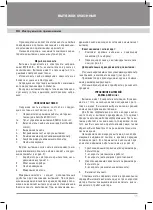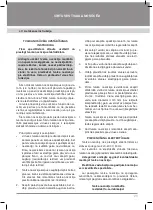
13
EN Application sheet
EN Application sheet
KITCHEN HOODS
KITCHEN HOOD INSTALLATION
INSTRUCTIONS
The kitchen hood should be installed and con-
nected to power supply only by a specialist.
Do not start mounting the kitchen hood and
removing the protective film until you make
sure that the kitchen hood is in working or-
der by connecting it to the power supply and
checking all its functions.
For this purpose, locate the hood case (see Fig. 1)
in such a way as to make it comfortable to relocate
the lower sliding panel to the extreme front posi-
tion and ensure free access to work modes switch.
Then the kitchen hood is connected to the power
supply and checked.
If the kitchen hood works correctly in all modes,
start mounting. If not, contact the organization
where you bought the kitchen hood or the war-
ranty workshop.
Your model belongs to the class of built-in kitchen
hoods. Different technical and designer variants of
mounting such kitchen hoods in the kitchen cabi-
net are possible.
Here are the important points:
- the visible part of the kitchen hood is the lower
sliding panel and the lower part of the case,
and the main case of the kitchen hood is hid-
den in the cabinet;
- regardless of the choice of air extraction mode,
connect the hood outlet with a flexible air con-
duit using the reducing flange and take the air
up through the cabinet (recirculation mode) or
connect it to the air shaft (extraction to the air
shaft).
1. There are four holes in the upper part of the
kitchen hood case where plastic plugs are in-
serted. These holes are used to fix the kitchen
hood to the cabinet (see Fig. 12).
2. The cabinet is usually made without a bottom,
and the middle shelf is located at the height set
in relation to the lower part of the cabinet so
that the hood case would be sunk into the cabi-
net.
3. The template inserted along with the instruc-
tions into the packing tare of the kitchen hood
is used to make a layout on the middle shelf of
the cabinet for screw holes and a flexible air
conduit
4. Use the same template for layout of the cabinet
ceiling to put out the flexible air conduit.
5. Screw holes are drilled and holes for the flex-
ible air conduit are made in the middle shelf.
6. Before the kitchen hood is put into the cabi-
net, install a plastic reducing flange with an
antiback valve to the relevant place above the
kitchen hood (Fig. 13). Put one edge of the flexi-
ble air conduit with the diameter of 120 mm (not
included in the set) on the reducing flange after
applying sealant to the place of junction and fix
it using a clamp (bought separately).
7. The kitchen hood is fixed with the help of
screws to the middle shelf of the cabinet, and
then its upper part is sunk into the cabinet.
8. After the kitchen hood has been mounted into
the cabinet, the latter is hung to the kitchen
wall.
CONNECTION TO POWER SUPPLY
The kitchen hood is connected to the power net-
work with the voltage of 220-240V, 50 Hz.
The kitchen hood should be connected to a wall
outlet with earthing to avoid electrocution.
It is absolutely prohibited to cut off the plug
during kitchen hood installation.
The damaged electrical cord should be re-
placed by a qualified service specialist.
For additional protection of the kitchen hood from
voltage drops in the network, connect it though an
additional automatic switch 6A.
The kitchen hood is installed.
Switch it on and use it as you please.
Summary of Contents for KAMILLA 600 inox
Page 52: ...www krona steel com ...














































